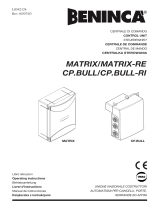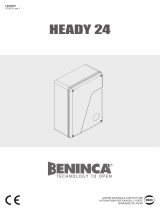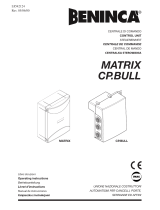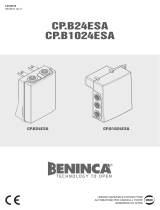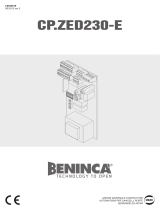Page is loading ...

CP.BISON OM
L8542943
11/2011 rev 0
UNIONE NAZIONALE COSTRUTTORI
AUTOMATISMI PER CANCELLI, PORTE
SERRANDE ED AFFINI

3
J1 DAS
Open
DAS N.C.
J1 DAS
Close
DAS 8K2
45
SHIELD
ANT
230V: F5A
115V: F10A
230V: T0,315
115V: T0,5
230V: T1A
115V: T1A
ENCODER
24Vac/1A
L
N
GND
1

4
24Vac 24Vac
COM
NC
RX1 TX1
TX1
24Vac
24Vac
COM
NC
RX2
RX2
RX1
TX2
TX2
tst1:On
tst2:On
24V
PHOTOT.
COM
PHOT O
PHOT C
2
3
SCA 24Vac
3W max
2ch:Off
serl:Off
L N
Service
Light
230V
Relè 24Vac
2ch
Radio
2ch:ON
serl:Off
2ch:Off
serl:on
891011 891011 891011
4
OPEN
OPEN
MINV:On
MINV:Off

12
EC declaration of confirmity
Manufacturer: Automatismi Benincà SpA.
Address: Via Capitello, 45 - 36066 Sandrigo (VI) - Italia
Herewith declares that: control unit CP.BISON OM.
complies with the following relevant provisions:
EMC guidelines: 89/336/CCE, 93/68/CEE
Low voltage guidelines: 73/23/CEE, 93/68/CEE
Benincà Luigi, Legal responsible.
Sandrigo, 10/10/2011.
WARNINGS
This manual has been especially written to be use by qualified
fitters.
None of the information provide in this manual can be consi-
dered as being of interest for the end users.
Preserve this manual for future needs.
The technician has to furnish all the information related to the
step by step function, the manual and the emergency function
of the operator, and to deliver the manual to the final user.
;
Foresee on the supply net an onnipolar switch or
selector with distance of the contacts equal or
superior to 3 mms.
Verify that of the electrical system there is an awry differential
interrupter and overcurrent protection.
Some typologies of installation require the connection of the
shutter to be link at a conductive mass of the ground according
to the regulations in force.
The electrical installation and the operating logic must comply
with the regulations in force.
The leads fed with different voltages must be physically
separate, or they must be suitably insulated with additional
insulation of at least 1 mm.
The leads must be secured with an additional fixture near
the terminals.
During installation, maintenance and repair, interrupt the
power supply before opening the lid to access the electrical
parts
Check all the connections again before switching on the
power.
The unused N.C. inputs must be bridged.
The descriptions and the present illustrations in this manual
are not binding. Leaving the essential characteristics of the
product unchanged, the manufacturer reserves himself the
right to bring any change of technical, constructive or com-
mercial character without undertaking himself to update the
present publication.
TECHNICAL DATA
Power supply
230 Vac 50/60 Hz
Output supply
1 motor 230Vac
Power maximum motor
1000 W
Output supply accessories
24Vdc 500mA max.
Protection level
IP54
Operating temp.
-20°C / +70°C
Radio receiver
433.92 MHz, built-in and configurable
(rolling-code or fixed+rolling-code+ ARC Advanced Rolling Code)
Rolling code transmitters supported
64

13
CP.BISON OM CONTROL UNIT
INPUT/OUTPUT FUNCTIONS
Terminal No. Function Description
1-2 Power supply Input, 230Vac 50Hz (1-Phase/2-Neutral)
3 GND
Ground connection. Use the connector preset on the fitting plate of the control unit.
Earthing is COMPULSORY, through this connection also the metal structure of motoriza-
tion are grounded.
4-5 Aerial Connection of the insertable radio receiver card (4-signal/5-display).
8-9 24Vac Output, power supply of accessories, 24VAC/1A max
10-11
SCA o
Service light
Normally Open clean contact, configurable as SCA (open gate light), timed service light (see
SERL Logic) or as second radio channel (see Logics 2 Ch).
12-13 PHOTO TEST
N.O. free contact. It is used to power photocell transmitters in TEST operating mode.
See diagram Fig.3 and TST1 and TST2 Logic.
14 COM Common for control inputs.
15 OPEN
Input, push-button for OPEN contact (Normally Open contact) Contact usable for timed open-
ings through timer.
16 CLOSE Input, CLOSE push-button (N.O. contact)
17 Step-by-Step Input, step-by-step push-button (N.O. contact)
18 PED
Input, pedestrian push-button (N.O. contact). It controls the partial opening. Configuration is
through parameter TPED. When TCA time has elapsed (if activated) a closure control signal is
sent.
19 COM Common, for limit switches and safety devices
20 STOP Input, STOP push-button (N.C. contact)
21 PHOT O
Input, (N.C. contact) for safety devices (e.g. photocells).
In the closing phase: the contact opening causes the motor stop. Common: when the photocell
is released, the motor inverts the movement direction (open).
In the opening phase: the contact opening causes the motor stop. When the photocell is re-
leased, the motor re-starts the opening operation.
22 SWO Input, OPEN limit switch (N.C. contact)
23 SWC Input, CLOSE limit switch (N.C. contact)
24 PHOT C
Input (N.C. contact) for safety devices (e.g. photocells).
In the closing phase: Configuration through PHCL Logic.
In the opening phase: Configuration through PHC Logic.
25-26 DAS
Input, safety edge
Resistive edge: “DAS” Jumper closed
Mechanical edge: “DAS” Jumper open
When the edge is activated, the gate movement is stopped and reversed for about 3s.
If the edge is not in use: “DAS” Jumper open, 25-26 terminals are short-circuited.
27-28-29 Motor
Connection of motor 230Vac - single-phase:
27-Phase/28-Common/29-Phase
27-30 Capacitor Connection of capacitor
31-32 Blinker Connection of blinker, 230Vac 40W max.
To check connections:
1) Cut-off power supply.
2) Manually release the wing, move it to approx. half-stroke and lock it again.
3) Reset power supply.
4) Send a step-by-step control signal by pressing the button or the remote control key.
5) The door/gate should move in the opening phase. Conversely, use the MINV logics to invert the opening direction.
6) Cut-off and restore power supply.
RUN SELF-LEARNING AND ANTI-CRUSHING DEVICE SETTING
When operator assembly and wiring is completed, parameters and logic are programmed, self learning allows the operator to learn
the stroke and torque.
Enter menu Auto and press the button < PGM >, PUSH will be displayed.
Press again the button < PGM >: self-learning is beginning: PRG will be displayed, and the control panel completes some opening/

14
closing cycles.
When the procedure is completed OK will be displayed.
This procedure can be followed from any position of the gate/door leaf and can be stopped at any moment by pressing keys <+> and
<-> at the same time, or through the activation of STOP/PHO/PHA/DAS/PP/PED inputs.
If the procedure is not successful, the wording ERR appears. Check that no obstacles or frictions are present.
PROGRAMMING
The programming of the various functions of the control unit is carried out using the LCD display on the control unit and setting the
desired values in the programming menus described below.
The parameters menu allows you to assign a numerical value to a function, in the same way as a regulating trimmer.
The logic menu allows you to activate or deactivate a function, in the same way as setting a dip-switch.
Other special functions follow the parameters and logic menus and may vary depending on the type of control unit or the software
release.
To access programming:
1 Press the button <PG>, the display goes to the first menu, Parameters “PAR”.
2 With the <+> or <-> button, select the menu you want (PAR>>LOG>>RADIO>>NMAN>>RES)
3 Press the button <PG>, the display shows the first function available on the menu.
4 With the <+> or <-> button, select the function you want.
5 Press the button <PG>, the display shows the value currently set for the function selected.
6 With the <+> or <-> button, select the value you intend to assign to the function.
7 Press the button <PG>, the display shows the signal “PRG” which indicates that programming has been completed.
Notes:
Simultaneously pressing <+> and <-> from inside a function menu allows you to return to the previous menu without making any
changes.
Simultaneously pressing <+> and <-> when the display is switched off shows the card software release.
Hold down the <+> key or the <-> key to accelerate the increase/decrease of the values.
After waiting 30s the control unit quits programming mode and switches off the display.
PARAMETERS, LOGIC AND SPECIAL FUNCTIONS
The tables below describe the individual functions available in the control unit.
PARAMETERS (PAR)
MENU FUNCTION
MIN-MAX-(Default)
MEMO
TCA
Automatic closure time. It is activated only with “TCA”=ON logic.
At the end of the preset time, the control unit controls a closure operation.
3-240-(40s)
TM
Operating time. It is activated only with logics ENC : OFF.
The operating time is adjusted during motor opening and closing phases.
1-250-(90s)
Tped
The passage left open by the gate leaf during the partial opening (pedestrian) is
adjusted.
5-100-(20%)
TSM
The area covered by the gate during the braking phase is adjusted.
0 = braking disabled.
0-100-(0%))
PMo
The torque applied to the motor in the opening phase is adjusted.* 1-99-(40%)
PMC
The torque applied to the motor in the closing phase is adjusted *. 1-99-(40%)
PSo
The torque applied to the motor during braking in the closing phase is adjusted.*
1-99-(50%)
PSC
The torque applied to the motor during braking in the opening phase is adjusted *
1-99-(50%)
SEAV
The trigger time of the anti-crash device (Encoder) is adjusted during the normal
speed phase*.
99: maximum sensitivity – 0: Minimum sensitivity
0-99-(0%)
SEAR
The trigger time of the anti-crash device (Encoder) is adjusted during the braking
phase*.
99: maximum sensitivity – 0: minimum sensitivity
0-99-(0%)
TLS
Activated only with SERL:ON Logic. The activation time of the service light is ad-
justed.
1-240-(60s)
ibra
The force of the motor brake is adjusted.
0: disabled braking - 1:minimum braking - 99: maximum braking
0-99-(50%)
* WARNING:
An incorrect setting of these parameters may result in a danger.
Comply with regulations in force!

15
LOGICS (LOG)
MENU FUNCTION
DEFAULT
MEMO
TCA
The automatic closure is enabled or disabled
On: enabled automatic closure
Off: disabled automatic closure
(ON)
IbL
The multi-flat function is enabled or disabled.
On: enabled multi-flat function. The P.P. (Step-by-step) impulse or the impulse of the
transmitter have no effect in the opening phase.
Off: disabled multi-flat function.
(OFF)
IBCA
PP and PED controls are enabled or disable during the TCA phase.
On: PP and PED control units are disabled.
Off: PP and PED control units are enabled.
(OFF)
SCL
The rapid closure is enabled or disabled
On: rapid closure is enabled. When the gate is open or moving, the photocell ac-
tivation causes the automatic closure of the gate after 3 s. It is activated only with
TCA:ON
Off: rapid closure is disabled.
(OFF)
PP
The operating mode of “P.P. Push button” and of the transmitter are selected.
On: Operation : OPEN > CLOSE > OPEN >
Off: Operation: OPEN > STOP > CLOSE > STOP >
(OFF)
PRE
Forewarning flashing light enabled or disabled.
On: enabled forewarning flashing light. The flashing light is activated 3 s before the
starting of the motor.
Off: disabled forewarning flashing light.
(OFF)
LTCA
During the TCA time, the blinker is enabled or disabled.
On: Activated blinker.
Off: De-activated blinker.
(OFF)
htr
The Operator function is enabled or disabled.
On: Operator function enabled.
During operation, the OPEN/CLOSE push-buttons must be kept pressed.
Off: Automatic operation.
(OFF)
IBCA
During the TCA phase, the PP and PED controls are enabled or disabled.
On: PP and PED controls are disabled.
Off: PP and PED controls are enabled.
(OFF)
ENC
The Encoder is enabled or disabled. See section “Operating mode with enabled/
disabled Encoder”
On: Encoder enabled – The anti-crash sensor is activated.
Off: Encoder disabled – The anti-crash sensor is deactivated.
(ON)
Cvar
The code programmable transmitters is enabled or disabled.
On: Radio receiver enabled only for rolling-code transmitters.
Off: Receiver enabled for rolling-code and programmable code transmitters (self-
learning and Dip Switch).
OFF
2ch
The second radio channel is enabled or disabled on terminals SCA (fig.2).
On: SCA output, preset as second radio channel. The
SERL logic should be OFF.
Off: AUX output can be preset as SCA, or by SERL logic (the programming of a radio
control in the RADIO 2CH menu allows for the pedestrian passage opening).
(OFF)
serL
The service light function to output SCA (Fig.2) is enabled or disabled.
On: At every operation, the contact is closed for the time preset with
TLS parameter
Use the auxiliary relay to control the light. 2CH logic should be preset on OFF.
Off: AUX output can be preset as SCA, or by 2CHlogic.
(OFF)
TST1
The test of photocells to PHOT O input is enabled or disabled.
On: Test is enabled. If the test is negative, no operation is performed.
Off: Test is disabled.
(OFF)
TST2
The test of photocells to PHOT C input is enabled or disabled.
On: Test is enabled. If the test is negative, no operation is performed.
Off: Test is disabled.
(OFF)

16
PHcl
The operating mode of the PHOT C input is selected.
On: PHOT C input is activated in both opening and closing phases.
In the opening phase: the contact opening causes the motor stop. When the photocell
is released, the motor restarts in the opening phase.
In closing phase: the contact opening causes the motor stop. When the photocell is
released, the motor inverts the movement direction (open).
Off: The PHOT C input is activated in the closing phase only.
In the closing phase: the contact opening causes the motor stop and the immediate
reversion of the operation direction (open).
(OFF)
SPN
The pickup function is enabled or disabled.
On: Enabled pickup. At the beginning of every operation, the motor operates at maxi-
mum torque for 2 sec.
Off: Start-ups are at braked speed for 2 seconds. Then the system speeds up to
standard speed.
(ON)
MINV
The opening direction of the motor is selected (see Fig. 4):
On: Right side motor mount
Off: Left side motor mount
(OFF)
REM
The remote storage of the radio transmitter codes is enabled or disabled (see par.
REMOTE LEARNING).
On: Enabled remote storage
Off: Disabled remote storage.
(ON)
RADIO (RADi)
MENU FUNCTION
PP
By selecting this function, the receiver is waiting for (Push) a transmitter code to be assigned to the step-by-step
function.
Press the transmitter key, which is to be assigned to this function.
If the code is valid, it will be stored in memory and OK will be displayed.
If the code is not valid, the Err message will be displayed.
2Ch
By selecting this function, the receiver is waiting for (Push) a transmitter code to be assigned to the second radio
channel.
Press the transmitter key, which is to be assigned to this function.
If the code is valid, it will be stored in memory and OK will be displayed.
If the code is not valid, the Err message will be displayed.
PED
When this function is selected, the receiver awaits (Push) a transmitter code to be assigned to the PED function.
Press the transmitter key, which is to be assigned to this function.
If the code is valid, it will be stored in memory and OK will be displayed.
If the code is not valid, the Err message will be displayed.
CLR
By selecting this function, the receiver is waiting for (Push) a transmitter code to be erased from memory.
If the code is valid, it will be stored in memory and OK will be displayed.
If the code is not valid, the Err message will be displayed.
RTR
The memory of the receiver is entirely erased. Confirmation for the operation is asked.
NUMBER OF CYCLES (Nman)
The number of cycles (open+close) completed by the system is displayed.
When the push-button <PG> is pressed once, the first 4 digits are displayed, if the push-button is pressed once more, the last 4
digits are displayed.
E.g. <PG> 0012 >>> <PG> 3456: 123.456 cycles were performed.
MAINTENANCE (maci)
This function allows to activate the indication of maintenance required after a certain number of operations, preset by the installer.
To activate and select the number of operations, proceed as follows:
Press the <PG> button, OFF is displayed, indicating that the function is disabled (default).
Select one of the numbers shown (from OFF to 100) by using the <+> and <-> keys . The figures express the value of hundreds of
cycles (e.g.: the number 50 means 5000 operations).
Press OK to activate the function. The PROG message is displayed.
When the flashing light flashes for around 10 sec at end of operation, this means that maintenance operations are needed.
RESET (RES)
RESET of the control unit. WARNING: Returns the control unit to the default values.
When the <PG> push-button is pressed once, the RES wording begins to flash, if the push-button<PG> is pressed once more, the
control unit is reset.
Note: neither the transmitter codes nor the position and stroked of the gate leaf will be erased from the receiver.

17
AUTOSET (AUTO)
The learning of the system stroke and the operating torque adjustment are carried out.
See paragraph SELF-LEARNING
PASSWORD (CODE)
It allows to type in an access protection code to the programming of the control unit.
A four-character alphanumeric code can be typed in by using the numbers from 0 to 9 and the letters A-B-C-D-E-F.
The default value is 0000 (four zeros) and shows the absence of a protection code.
While typing in the code, this operation can be cancelled at any moment by pressing keys + and – simultaneously. Once the password
is typed in, it is possible to act on the control unit by entering and exiting the programming mode for around 10 minutes in order to
allow adjustments and tests on functions.
By replacing the 0000 code with any other code, the protection of the control unit is enabled, thus preventing the access to any other
menu. If a protection code is to be typed in, proceed as follows:
- select the Code menu and press OK.
- the code 0000 is shown, also in the case a protection code has been previously typed in.
- the value of the flashing character can be changed with keys + and -.
- press OK to confirm the flashing character, then confirm the following one.
- after typing in the 4 characters, a confirmation message “CONF” appears.
- after a few seconds, the code 0000 appears again
- the previously stored protection code must be reconfirmed in order to avoid any accidental typing in.
If the code corresponds to the previous one, a confirmation message “OK” appears.
The control unit automatically exits the programming phase. To gain access to the Menus again, the stored protection code must
be typed in.
IMPORTANT: TAKE NOTE of the protection code and KEEP IT IN A SAFE PLACE for future maintenance opera-
tions. To remove the code from a protected control unit, enter the programming mode with the password and
reset the code to the 0000 default value.
IF YOU LOOSE THE CODE, PLEASE CONTACT THE AUTHORISED SERVICE CENTER FOR THE TOTAL RESET OF
THE CONTROL UNIT.
ATTENTION:
After any LOGIC change or control panel reset, it is necessary to perform a self-learning procedure
(Menu Auto - See Stroke self learning)
OPERATING MODE WITH ENABLED/DISABLED ENCODER
With ENC LOGICS =ON:
- the anti-crash sensor is activated. Adjust sensitivity through parameters SEAV and SEAR in compliance with regulations in force. An
accurate adjustment of the motor brake (IBRA parameter) may help compliance with safety regulations as well.
- if braking is activated by setting parameter TSM from 0 to a higher value, a complete operation, from limit switch to limit switch, shall
be performed without stops to allow for the gate stoke memorisation.
Once the stroke is stored in memory, the control unit will manage braking automatically in both opening and closing phases. Braking
can be increased or decreased through parameter TSM.
In the event of power failure, the stroke is constantly updated and stored in memory together with the gate position.
With ENC LOGICS =OFF:
- the anti-crash sensor is disabled.
- if parameter TSM>0 (braking activated), the first operation is performed ad normal speed for the gate stroke memorisation, also in
the event of power failure.
TRANSMITTER REMOTE LEARNING
If the transmitter code is already stored in the receiver, the remote radio learning can be carried out (without accessing the control
unit). The REM logics must be ON.
IMPORTANT: The procedure should be carried out with gate in the opening phase, during the TCA dwell time.
Proceed as follows:
1 Press the hidden key of the transmitter, the code of which has already been stored in memory.
2 Within 5 seconds, press the already memorised transmitter key corresponding to the channel to be matched to the new transmitter.
The flashing light switches on.
3 Within 10 seconds, press the hidden key of the new transmitter.
4 Within 5 seconds, press the key of the new transmitter to be matched to the channel selected at item 2. The flashing light switches
off.
5 The receiver stores the new transmitter code and exits from the programming mode immediately.

18
DIAGNOSTICS
In the event of malfunctions, by pressing key + or - the status of all inputs (limit switches, control and safety) can be displayed. One
segment of the display is linked to each input. In the event of failure it switches on according to the following scheme.
PHOT 0
SWC
STOP
SWO
PHOT C
DAS
P.P. PED OPEN CLOSE
FUSES
F1 Protection fuse of transformer
F2 Output protection fuse of accessories and signals
F3 Output protection fuse for motor and blinker
ERROR MESAGES
Some messages that are displayed in the event of malfunctions are shown hereunder:
Err1
Motor Technical assistance is required.
Err4
Error, PHOT O circuit check Check connections, alignment of PHOT O photocell or obstacle present.
Err5
Error, PHOT C circuit check Check connections, alignment of PHOT C photocell or obstacle present.
ENC
Error, encoder Error to connection or faulty encoder.
Amp
Obstacle detection An obstacle present is indicated (anti-crash device).
WASTE DISPOSAL
If the product must be dismantled, it must be disposed according to regulations in force regarding the differentiated waste disposal
and the recycling of components (metals, plastics, electric cables, etc..). For this operation it is advisable to call your installer or a
specialised company.
/
